Today’s post is going to be more of a gallery. I want to build on my last post (The Colorful Regency) and highlight print gowns. The two methods of printing were block and roller (which are exactly what they sound like). Block predates roller, which was invented in the late 18thC and really came into its own in the 1820s.
It was common to see “penciling” combined with block printing. What this means is that the blue part (and sometimes the yellow part) of the design was painted on after the main pattern or “springs” were printed (yes, that’s what “sprigged muslin” means, printed with a small repeating design).
An unusual method of printing that was period was “chine”. The fabric was printed on the warp before weaving, resulting in a blurred design. I couldn’t find one from the Regency, so there’s an 18thC example in the pictures below, but it WAS used throughout the Georgian period (including the Regency) and Victorian era and beyond.
A bit about terminology: Calico is a general catch-all term for medium-weight cotton fabric of Indian origin (heavier than muslin). Chintz is calico which has been printed or painted. Many sources state that chintz was also glazed (note: glazed fabrics can’t be laundered!), but this clearly does not seem to be true of all chintz. These fabrics were commonly used for day dresses throughout the entire Regency period.
Indiennes was the term applied to French imitations of Indian chintz,, the most famous of which were produced in Jouy (such as the copperplate printed scenes we now call “toile,” which were only used for furnishings in the 18th and 19th centuries, so don’t dress your heroine in them).
As you’ll see below, white and cream backgrounds were common, but so were da
rk backgrounds in any color you can think of.
Jane Austen’s World has a nice post on this topic with more examples that are worth looking at when you’re done here.
- Blue “Sprigged” gown c. 1800-1810

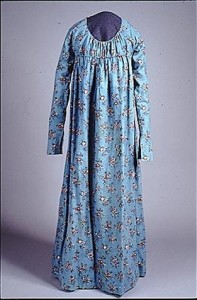
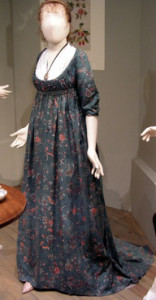
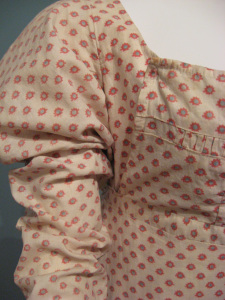
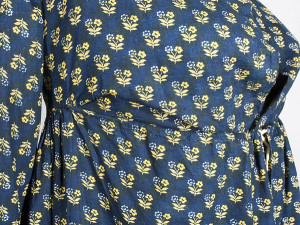
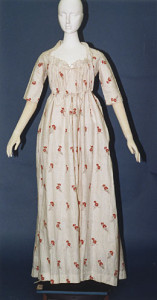
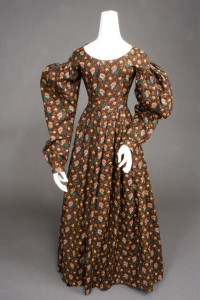
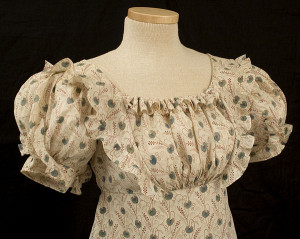
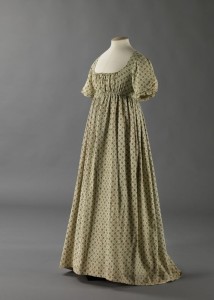
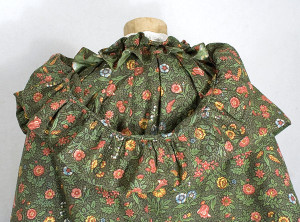
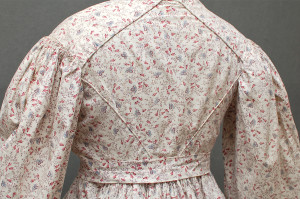
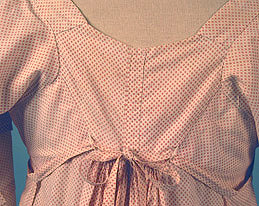

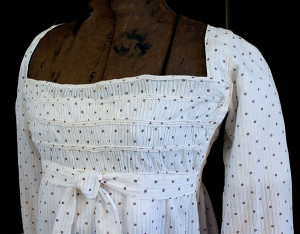
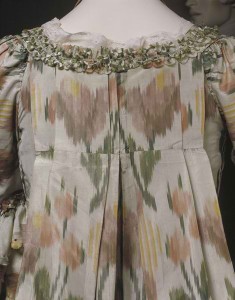
I still (even after your last post) find the dark backgrounds such a surprise, having had a vague idea that the ballrooms were full of pastel colours. Thank you for all this detailed information!
Thanks, Isobel! Awesome post. I love some of these, especially the dark ones. That dark blue c.1800 gown is one I’d love to have. The chine printing is a surprise. It looks so modern!
You all might enjoy the “Curtain Along” gowns a group of re-enactors did:
http://www.festiveattyre.com/2013/08/curtain-along-meetup.html
So pretty!!!! Thanks for this fabulous info!
Great post, Isobel — thanks! I remember reading that the costume department on the 90s BBC Pride & Prejudice hand-printed the fabrics for the principal characters’ dresses. Fantastic attention to detail.
Another amazing post, Isobel ! The patterns are so crisp, clear and in some cases abstract. The methods used to create them are another sources of amazement. Both of the blue gowns are lovely and I actually like the pattern of the last gown as well.
A Finnish costumer not only hand sewed her dress but block printed her sprig muslin herself
http://shadowofmyhand.blogspot.com.au/2014/01/red-and-white-block-printed-gown.html
I love the mix and matching of Regency era women’s clothing as this blogger shows to good effect with her pictures of the finished dress
Oh, that’s amazing! Thanks for sharing.
Another fascinating post, Isobel! And great illustrations! I always assumed that “sprigged” meant the design was floral with stems and leaves (sprigs) and never realized it could refer to any small repeating pattern, but the expanded use of the term makes sense. Thanks for sharing all your fashion knowledge with us!!
Thank you so much for his, Isobel! I love your posts. Tweeted and shared on FB.
Thank you!
Some are so pretty, I wouldn’t mind wearing them myself. Thanks for such an informative post.